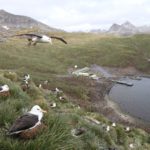Spatial Segregation of Seabirds at South Georgia
Spatial Segregation of Seabirds at South Georgia
- Start date
- 1 March, 2021
- End date
- 30 November, 2024
Seabirds are amongst the most globally threatened birds, often as a consequence of incidental mortality (bycatch) in fisheries [1] [2]. At South Georgia, wandering albatrosses have declined since the 1970s [3], and are listed by the Agreement on the Conservation of Albatrosses and Petrels (ACAP) as one of nine global High-Priority populations for conservation. Another species at South Georgia, the white-chinned petrel, is listed as Vulnerable by IUCN and is the species most commonly bycaught in Southern Ocean fisheries. Understanding the at-sea distributions and fisheries overlap of these species are key goals of the Albatross Conservation Action Plans and Marine Protected Area Research and Monitoring Plan of the Government of South Georgia and the South Sandwich Islands (GSGSSI).
South Georgia holds globally important populations of albatrosses and petrels [2] [3]. Although bycatch has been reduced to negligible levels in the local fisheries, these and other threatened seabirds remain at risk from longline and trawl fisheries elsewhere in the Southern Ocean [2]. The rates of population decline differ considerably among sites around South Georgia [3] [4]. The albatrosses and petrels breeding on Bird Island have been tracked during the breeding and non-breeding seasons, indicating that they overlap with multiple fisheries within Exclusive Economic Zones (EEZs) and in the High Seas [5]. So far there are no tracking data from any other site in the island group, even though the birds breeding elsewhere may encounter risks at different times of year from different fishing fleets. By enhancing our knowledge of inter-colony variation in at-sea foraging distributions we can better understand and mitigate bycatch risk, and focus management at appropriate spatial and temporal scales.
In December 2022, Platform Terminal Transmitters (PTTs) were attached to breeding white-chinned petrels at King Edward Point (KEP) and Bird Island. The birds are tracked in near real-time using the Argos system, and their locations shown on the following map.


















Click on a track to find out how far the bird has gone from the release location.
In January 2022, Platform Terminal Transmitters (PTTs) were attached to breeding white-chinned petrels at Cooper Island and Bird Island, and wandering albatrosses at Prion Island. The birds were tracked in near real-time using the Argos system, and their locations shown on the following map.


















Click on a track to find out how far the bird has gone from the release location.
This project was funded by Darwin Plus, GSGSSI and Friends of South Georgia Island.
Further reading
[1] Pardo, D., Forcada, J., Wood, A.G., Tuck, G.N., Ireland, L., Pradel, R., J.P. Croxall and Phillips, R.A. (2017) Additive effects of climate and fisheries drive catastrophic declines in multiple albatross species. Proceedings of the National Academy of Science of the Unites States of America 114, E10829-E10837. https://doi.org/10.1073/pnas.1618819114
[2] Phillips, R.A., Gales, R., Baker, G.B., Double, M.C., Favero, M., Quintana, F., Tasker, M.L., Weimerskirch, H., Uhart, M., and Wolfaardt, A. (2016) The conservation status and priorities for albatrosses and large petrels. Biological Conservation 201, 169-183. https://doi.org/10.1016/j.biocon.2016.06.017
[3] Poncet, S., Wolfaardt, A.C., Black, A., Browning, S., Lawton, K., Lee, J., Passfield, K., Strange, G. and Phillips, R.A. (2017) Recent trends in numbers of wandering (Diomedea exulans), black-browed (Thalassarche melanophris) and grey-headed (T. chrysostoma) albatrosses breeding at South Georgia. Polar Biology 40, 1347-1358. https://doi.org/10.1007/s00300-016-2057-0
[4] Rackete, C., Poncet, S., Good, S., Phillips, R.A., Passfield, K. and Trathan, P.N. (2021) Variation among colonies in breeding success and population trajectories of wandering albatrosses Diomedea exulans at South Georgia. Polar Biology 44, pp. 221-227. https://doi.org/10.1007/s00300-020-02780-6
[5] Clay, T.C., Small, C., Tuck, G.N., Pardo, D., Carneiro, A.P.B., Wood, A.G., Croxall, J.P., Crossin, G.T. and Phillips, R.A. (2019) A comprehensive large-scale assessment of fisheries bycatch risk to threatened seabird populations. Journal of Applied Ecology 56, pp. 1882-1893. https://doi.org/10.1111/1365-2664.13407
We aim to characterise variation in colony-specific overlap of birds with fishing fleets, identify high-risk areas, and help focus engagement with fisheries to better understand and address impacts of bycatch on these threatened species.
The following maps show animations of satellite tracked locations generated using moveVis.
December 2022 deployments
![]()
January 2022 deployments
![]()
